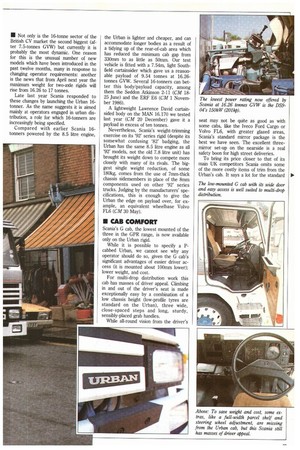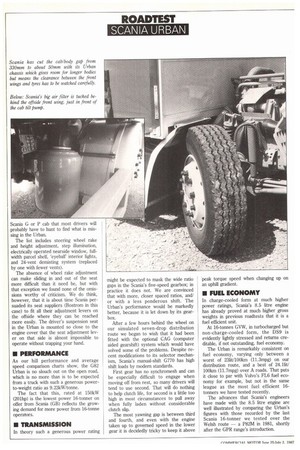POWERFUL CITY STREET LIGHT
Page 38

Page 39

Page 40

Page 41

If you've noticed an error in this article please click here to report it so we can fix it.
Operators want more .ower from their 16-tonners. Scania's Urban satisfies that demand and its cab is better than most, but it's performance fails to stand out from the crowd. • Not only is the 16-tonne sector of the British CV market the second biggest (after 7.5-tonnes GVW) but currently it is probably the most dynamic. One reason for this is the unusual number of new models which have been introduced in the past twelve months, many in response to changing operator requirements: another is the news that from April next year the maximum weight for two-axle rigids will rise from 16.26 to 17 tonnes.
Late last year Scania responded to these changes by launching the Urban 16tonner. As the name suggests it is aimed mainly at operators engaged in urban distribution, a role for which 16-tonners are increasingly being specified.
Compared with earlier Scania 16tonners powered by the 8.5 litre engine, the Urban is lighter and cheaper, and can accommodate longer bodies as a result of a tidying up of the rear-of-cab area which has reduced the minimum cab gap from 330mm to as little as 50mm. Our test vehicle is fitted with a 7.54m, light Southfield curtainsider which gave us a reasonable payload of 9.54 tonnes at 16.26tonnes GVW. Several 16-tonners can better this body/payload capacity, among them the Seddon Atkinson 2-11 (CM 1825 June) and the ERF E6 (CM 1 November 1986).
A lightweight Lawrence David curtainsided body on the MAN 16.170 we tested last year (CM 20 December) gave it a payload in excess of ten tonnes.
Nevertheless, Scania's weight-trimming exercise on its '92' series rigid (despite its somewhat confusing '82' badging, the Urban has the same 8.5 litre engine as all '92' models, not the old 7.8 litre unit) has brought its weight down to compete more closely with many of its rivals. The biggest single weight reduction, of some 180kg, comes from the use of 7ffun-thick chassis sidemembers in place of the 8mm components used on other '92' series trucks. Judging by the manufacturers' specifications, this is enough to give the Urban the edge on payload over, for example, an equivalent wheelbase Volvo FL6 (CM 30 May).
• CAB COMFORT
Scania's G cab, the lowest mounted of the three in the CPR range, is now available only on the Urban rigid.
While it is possible to specify a cabbed Urban, Urban, we cannot see why any operator should do so, given the G cab's significant advantages of easier driver access (it is mounted about 100mm lower); lower weight, and cost.
For multi-drop distribution work this cab has masses of driver appeal. Climbing in and out of the driver's seat is made exceptionally easy by a combination of a low chassis height (low-profile tyres are standard on the Urban), three wide, close-spaced steps and long, sturdy, sensibly-placed grab handles.
While all-round vision from the driver's seat may not be quite as good as with some cabs, like the Iveco Ford Cargo or Volvo FL6, with greater glazed areas, Scania's standard mirror package is the best we have seen. The excellent threemirror set-up on the nearside is a real safety boon for high street deliveries.
To bring its price closer to that of its main UK competitors Scania omits some of the more costly items of trim from the Urban's cab. It says a lot for the standard Scania G or P cab that most drivers will probably have to hunt to find what is missing in the Urban.
The list includes steering wheel rake and height adjustment, step illumination, electrically operated nearside window, fullwidth parcel shelf, `eyeball' interior lights, and 24-vent demisting system (replaced by one with fewer vents).
The absence of wheel rake adjustment can make sliding in and out of the seat more difficult than it need be, but with that exception we found none of the omissions worthy of criticism. We do think, however, that it is about time Scania persuaded its seat suppliers (Bostrom in this case) to fit all their adjustment levers on the offside where they can be reached more easily. The driver's suspension seat in the Urban is mounted so close to the engine cover that the seat adjustment lever on that side is almost impossible to operate without trapping your hand.
• PERFORMANCE
As our hill performance and average speed comparison charts show, the G82 Urban is no slouch out on the open road, which is no more than is to be expected from a truck with such a generous powerto-weight ratio as 9.23kW/torme.
The fact that this, rated at 150kW (201hp) is the lowest power 16-tonner on offer from Scalia (GB) reflects the growing demand for more power from 16-tonne operators.
• TRANSMISSION
In theory such a generous power rating might be expected to mask the wide ratio gaps in the Scania's five-speed gearbox; in practice it does not. We are convinced that with more, closer spaced ratios, and/ or with a less ponderous shift. The Urban's performance would be markedly better, because it is let down by its gearbox.
After a few hours behind the wheel on our simulated seven-drop distribution route we began to wish that it had been fitted with the optional CAG (computer aided gearshift) system which would have solved some of the problems. Despite recent modifications to its selector mechanism, Scania's manual-shift G770 has high shift loads by modern standards.
First gear has no synchromesh and can be especially difficult to engage when moving off from rest, so many drivers will tend to use second. That will do nothing to help clutch life, for second is a little too high in most circumstances to pull away when fully laden without considerable clutch slip.
The most yawning gap is between third and fourth, and even with the engine taken up to governed speed in the lower gear it is decidedly tricky to keep it above
-peak torque speed when changing up on an uphill gradient.
• FUEL ECONOMY
In charge-cooled form at much higher power ratings, Scania's 8.5 litre engine has already proved at much higher gross weights in previous roadtests that it is a fuel efficient unit.
At 16-tonnes GVW, in turbocharged but non-charge-cooled form, the DS9 is evidently lightly stressed and returns creditable, if not outstanding, fuel economy.
The Urban is remarkably consistent on fuel economy, varying only between a worst of 231it/100km (11.3mpg) on our distribution route, and a best of 24.11it/ 100km (11.7mpg) over A roads. That puts it dose to par with Volvo's FL6 fuel economy for example, but not in the same league as the most fuel efficient 16tonners we have tested recently.
The advances that Scania's engineers have made with the 8.5 litre engine are well illustrated by comparing the Urban's figures with those recorded by the last Scania 16-tonner we tested over the Welsh route — a P82M in 1981, shortly after the GPR range's introduction. The P82 achieved an average of only 26.851k/100km (10.52mpg), at a much slower average speed of 60.4km/h (37.5mph).
• BRAKING
Among the brake system changes introduced by Scania with the Urban is a faster response air actuation system and a reduction in front brake lining width from 178 to 127mm. Intriguingly, the company also now describes its brake system as an ECE (Economic Commission for Europe) type, rather than an EEC type as before.
Our test vehicle had a front brake judder and a slight drag on one of the rear brakes, whose lining width is unchanged at 203mm, but no more serious shortcomings. We were impressed with the effectiveness of the exhaust brake, a happy result of a relatively large capacity engine at this gross weight, and with the sensible location of its control button, within easy reach of the driver's left foot.
We also like the revised park brake lever position — it is less awkward to reach and has a more positive action. Despite working only on the rear axle, the park brake is also highly effective.
• SUMMARY
Scania must be commended for having taken careful note of what operators of 16-tonners are looking for in new vehicles and for having responded quickly and positively to many of their demands. The Urban does the job for which it is primarily intended in a generally efficient manner.
Its cab is as good for an urban distribution vehicle as that of any of its rivals but in other criteria such as price, weight and fuel economy the latest Scalia 16-tonner just fails to make the top grade.
The biggest fly in the Urban ointment is the five-speed manual shift Scania gearbox. We would like to see CAG become standard on the Urban instead of an expensive £1,800 option.
If Scalia could absorb the best part of that cost it would really have an urban distribution vehicle that would make its competitors sit up and take notice.
0 by Tim Blakemore




















































































































































